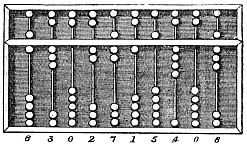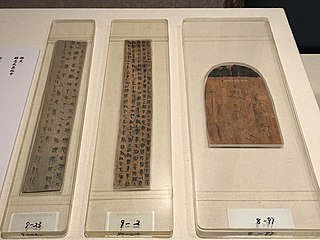
An abacus, also called a counting frame, is a hand-operated calculating tool which was used from ancient times in the ancient Near East, Europe, China, and Russia, until the adoption of the Arabic numeral system. An abacus consists of a two-dimensional array of slidable beads. In their earliest designs, the beads could be loose on a flat surface or sliding in grooves. Later the beads were made to slide on rods and built into a frame, allowing faster manipulation.
The duodecimal system, also known as base twelve or dozenal, is a positional numeral system using twelve as its base. In duodecimal, the number twelve is denoted "10", meaning 1 twelve and 0 units; in the decimal system, this number is instead written as "12" meaning 1 ten and 2 units, and the string "10" means ten. In duodecimal, "100" means twelve squared, "1000" means twelve cubed, and "0.1" means a twelfth.
In linguistics, a numeral in the broadest sense is a word or phrase that describes a numerical quantity. Some theories of grammar use the word "numeral" to refer to cardinal numbers that act as a determiner that specify the quantity of a noun, for example the "two" in "two hats". Some theories of grammar do not include determiners as a part of speech and consider "two" in this example to be an adjective. Some theories consider "numeral" to be a synonym for "number" and assign all numbers to a part of speech called "numerals". Numerals in the broad sense can also be analyzed as a noun, as a pronoun, or for a small number of words as an adverb.
Tien Gow or Tin Kau is the name of Chinese gambling games played with either a pair of dice or a set of 32 Chinese dominoes. In these games, Heaven is the top rank of the civil suit, while Nine is the top rank of the military suit. The civil suit was originally called the Chinese (華) suit while the military suit was called the barbarian (夷) suit but this was changed during the Qing dynasty to avoid offending the ruling Manchus. The highly idiosyncratic and culture-specific suit-system of these games is likely the conceptual origin of suits, an idea that later is used for playing cards. Play is counter-clockwise.

In mathematics, a multiplication table is a mathematical table used to define a multiplication operation for an algebraic system.

Sugarloaf Township is a township in Columbia County, Pennsylvania. It is part of Northeastern Pennsylvania.
English number words include numerals and various words derived from them, as well as a large number of words borrowed from other languages.

A vigesimal or base-20 (base-score) numeral system is based on twenty. Vigesimal is derived from the Latin adjective vicesimus, meaning 'twentieth'.

Napier's bones is a manually-operated calculating device created by John Napier of Merchiston, Scotland for the calculation of products and quotients of numbers. The method was based on lattice multiplication, and also called rabdology, a word invented by Napier. Napier published his version in 1617. It was printed in Edinburgh and dedicated to his patron Alexander Seton.
-yllion is a proposal from Donald Knuth for the terminology and symbols of an alternate decimal superbase system. In it, he adapts the familiar English terms for large numbers to provide a systematic set of names for much larger numbers. In addition to providing an extended range, -yllion also dodges the long and short scale ambiguity of -illion.

Positional notation usually denotes the extension to any base of the Hindu–Arabic numeral system. More generally, a positional system is a numeral system in which the contribution of a digit to the value of a number is the value of the digit multiplied by a factor determined by the position of the digit. In early numeral systems, such as Roman numerals, a digit has only one value: I means one, X means ten and C a hundred. In modern positional systems, such as the decimal system, the position of the digit means that its value must be multiplied by some value: in 555, the three identical symbols represent five hundreds, five tens, and five units, respectively, due to their different positions in the digit string.
The soroban is an abacus developed in Japan. It is derived from the ancient Chinese suanpan, imported to Japan in the 14th century. Like the suanpan, the soroban is still used today, despite the proliferation of practical and affordable pocket electronic calculators.
An autogram is a sentence that describes itself in the sense of providing an inventory of its own characters. They were invented by Lee Sallows, who also coined the word autogram. An essential feature is the use of full cardinal number names such as "one", "two", etc., in recording character counts. Autograms are also called 'self-enumerating' or 'self-documenting' sentences. Often, letter counts only are recorded while punctuation signs are ignored, as in this example:
This sentence employs two a's, two c's, two d's, twenty-eight e's, five f's, three g's, eight h's, eleven i's, three l's, two m's, thirteen n's, nine o's, two p's, five r's, twenty-five s's, twenty-three t's, six v's, ten w's, two x's, five y's, and one z.

The suanpan, also spelled suan pan or souanpan) is an abacus of Chinese origin first described in a 190 CE book of the Eastern Han dynasty, namely Supplementary Notes on the Art of Figures written by Xu Yue. However, the exact design of this suanpan is not known. Usually, a suanpan is about 20 cm (8 in) tall and it comes in various widths depending on the application. It usually has more than seven rods. There are two beads on each rod in the upper deck and five beads on each rod in the bottom deck. The beads are usually rounded and made of a hardwood. The beads are counted by moving them up or down towards the beam. The suanpan can be reset to the starting position instantly by a quick jerk around the horizontal axis to spin all the beads away from the horizontal beam at the center.

Mathematics emerged independently in China by the 11th century BCE. The Chinese independently developed a real number system that includes significantly large and negative numbers, more than one numeral system, algebra, geometry, number theory and trigonometry.
Xiàzhì is the 10th solar term, and marks the summer solstice, in the traditional Chinese lunisolar calendar dividing a year into 24 solar terms.

145th Street is a major crosstown street in the Harlem neighborhood, in the New York City borough of Manhattan. It is one of the 15 crosstown streets mapped out in the Commissioner's Plan of 1811 that established the numbered street grid in Manhattan. It forms the southern border of the Sugar Hill neighborhood within Harlem.
Miship, or Chip, is an Afro-Asiatic language spoken in Plateau State, Nigeria. Doka is a dialect. Blench lists the two dialects Longmaar and Jiɓaam.

The Battle of Tonkin River was a major naval battle fought in northern Vietnam between the pirates of Shap Ng-tsai and the British Royal Navy with aid from the Qing Chinese navy and the Tonkinese. The 1849 expedition led to the destruction of Shap Ng-tsai's fleet and the loss of over 2,000 men. The battle occurred over a three-day period at the mouth of the Tonkin River, near present-day Hai Phong.

The Liye Qin Slips is a large collection of bamboo slips which were unearthed from Liye Ancient City in Longshan County, Hunan, China in 2002. It is one of China's most important archaeological discoveries of the 21st century. Archaeologists found more than 37,000 pieces of bamboo slips, on which more than 200,000 Chinese characters record government and legal documents of the Qin dynasty. It is considered the most important archaeological discovery of the Qin dynasty after the Terracotta Army unearthed in 1973 in Xi'an.












